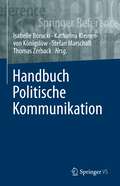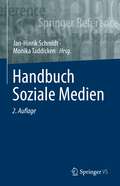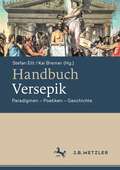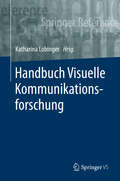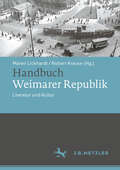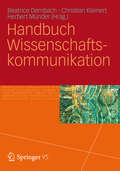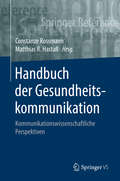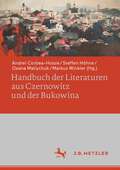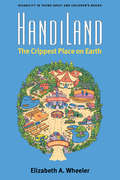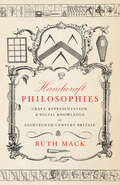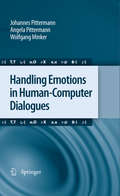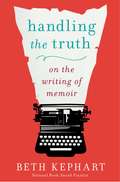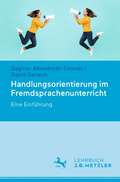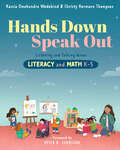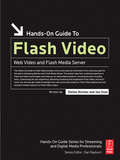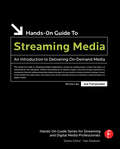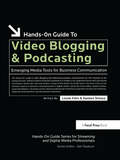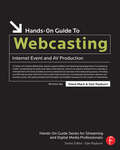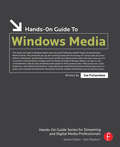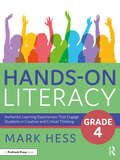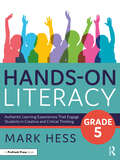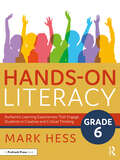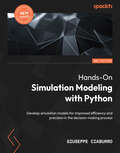- Table View
- List View
Handbuch Politische Kommunikation
by Thomas Zerback Isabelle Borucki Stefan Marschall Katharina Kleinen-von KönigslöwAngesichts von Globalisierung, Individualisierung und Digitalisierung haben sich die Umwelten, Bedingungen und Folgen politischer Kommunikation fundamental gewandelt. Das stellt auch die Erforschung der politischen Kommunikation vor neue Herausforderungen. Diese schlagen sich in der Theorieentwicklung, in den Themen der Forschung, aber vor allem auch im methodischen Zugriff nieder. Angesichts dieses umfassenden Wandels bietet das Handbuch zum einen eine aktuelle Bestandsaufnahme der Forschung zur politischen Kommunikation. Neben dem State of the art will es zum anderen Entwicklungstrends der kommenden Jahre, insbesondere im Lichte der Digitalisierung, herauszeichnen und dabei diskutieren, wie die Forschung darauf reagieren kann.Das Handbuch ist konsequent interdisziplinär angelegt, es wird von Vertreter:innen der Kommunikationswissenschaft und der Politikwissenschaft gemeinsam herausgegeben. Die Autorinnen und Autoren der Beiträge stammen ebenfalls aus beiden Disziplinen. Auch in der thematischen Abdeckung berücksichtigt das Handbuch die beiden Perspektiven und schlägt darüber hinaus Brücken zu verwandten Forschungsbereichen, unter anderem zur Psychologie, Soziologie, Staatswissenschaft sowie Informatik.
Handbuch Soziale Medien
by Jan-Hinrik Schmidt Monika TaddickenSoziale Medien erleichtern es Menschen, Informationen aller Art zu teilen und soziale Beziehungen zu pflegen. Sie sind in den letzten Jahren und Jahrzehnten zu einem wesentlichen Bestandteil der digitalen Kommunikation geworden und verändern die Strukturen gesellschaftlicher Öffentlichkeit, aber auch den alltäglichen Austausch über privat-persönliche Themen. Ihre kommunikative Architektur nährt Hoffnungen auf verbesserte gesellschaftliche Partizipation genauso wie Befürchtungen, immer mehr Bereiche des Lebens würden kommerzialisiert und überwacht. Das Handbuch bereitet den aktuellen Forschungs- und Diskussionsstand zu Nutzung, gesellschaftlicher Einbettung und Folgen der sozialen Medien aus der Kommunikationswissenschaft und den angrenzenden Sozialwissenschaften auf. Für die zweite Auflage wurden die Beiträge überarbeitet und aktualisiert sowie das Handbuch um neue Beiträge ergänzt.
Handbuch Versepik: Paradigmen – Poetiken – Geschichte
by Kai Bremer Stefan ElitDie klassische Gattung des Versepos von Milton bis Klopstock ist nach dem Ende ihrer letzten Hochphasen im europäischen Raum (je nach Sprachkultur zwischen 1750 und 1850) wenig beachtet, obschon weiterhin eine erstaunliche Breite an Formen und Inhalten zu finden ist. Das Handbuch will den bekannten klassischen und vor allem den modernen, vielsprachigen Bestand von Versepik interdisziplinär und systematisch beschreiben und dabei zugleich Wege für weitergehende Arbeiten weisen. Ein erster Teil des Handbuchs beleuchtet allgemeine literatur- und kulturwissenschaftliche Aspekte. Ein weiterer Teil rekapituliert die ‚klassischen’ Epochen von der Antike bis ins 17. Jahrhundert. Der dritte Teil widmet sich dezidiert ausführlicher dem bis heute wohl größten offenen Feld, nämlich der Weiterentwicklung der europäischen Versepiken in den wichtigsten Sprachkulturen (v.a. Romania, anglo-amerikanischer, deutschsprachiger, slavischer Raum) seit der vorgeblichen Ablösung der alten Gattung durch die ‚modernere’ Prosa bzw. Romanliteratur.
Handbuch Visuelle Kommunikationsforschung
by Katharina LobingerDas Handbuch liefert einen umfassenden Einblick in zentrale Theorien, Forschungsfelder, Methoden und aktuelle Herausforderungen der Visuellen Kommunikationsforschung. Ziel ist es, einen State of the Art-Überblick über das dynamische Forschungsfeld zu geben, dabei traditionelle wie innovative Themenbereiche abzubilden, methodische Anleitungen zu geben und für kritische Aspekte der visuellen Forschung zu sensibilisieren.
Handbuch Weimarer Republik: Literatur und Kultur
by Robert Krause Maren LickhardtDie Zeit der Weimarer Republik steht heute für Kriegszerstörungen, Armut, Gewalt auf den Straßen, Massenarbeitslosigkeit und Inflation genauso wie für eine neue Unterhaltungskultur, Rausch, Dekadenz und revolutionäre Umbrüche in Kunst, Kultur und Wissenschaft. In diesem komplexen Spannungsfeld entstehen neuartige literarische Werke, das Kino entwickelt sich rasant, Radio und Pressewesen gehen neue Wege, gesellschaftliche Rollenbilder ändern sich. Das Handbuch informiert über Literatur, Kultur und Medienlandschaft dieser Zeit. Es behandelt einerseits kanonische Werke und entdeckt andererseits weniger beachtete Kulturschaffende neu, wobei die Populärkultur und die so genannte Hochkultur gleichermaßen Beachtung finden.
Handbuch Wissenschaftskommunikation
by Herbert Münder Christian Kleinert Beatrice DernbachDer Band bietet einen Überblick über die Wissenschaftskommunikation unter vielen Perspektiven: Ausgehend von den politischen, ökonomischen und sozialen Rahmenbedingungen, unter denen Wissenschaft und Wissenschaftskommunikation stattfinden, werden die institutionellen Akteure auf nationaler und internationaler Ebene sowie Best-practice-Beispiele vorgestellt. Thematisiert werden ebenso die Perspektive der Wissenschaftskommunikation als Risiko- und Krisenkommunikation, das Verhältnis von Wissenschaftskommunikation zu Medien und Journalismus sowie die Evaluation von Wissenschaftskommunikation.
Handbuch der Gesundheitskommunikation: Kommunikationswissenschaftliche Perspektiven (Springer Reference Sozialwissenschaften Ser.)
by Constanze Rossmann Matthias R. HastallDas Handbuch gibt einen Überblick zum aktuellen Forschungsstand der Gesundheitskommunikation. Im Fokus stehen kommunikationswissenschaftliche Zugänge und Erkenntnisse sowie die Vorteile und Herausforderungen einer stärkeren Evidenzbasierung von Kommunikationsempfehlungen. Die Sektionen des Handbuchs reflektieren einerseits die zentralen Elemente des Kommunikationsprozesses und andererseits die wichtigsten Anwendungskontexte. Das Handbuch richtet sich an Studierende, Wissenschaftlerinnen und Wissenschaftler unterschiedlicher Disziplinen genauso wie an Expertinnen und Experten aus der Praxis.
Handbuch der Literaturen aus Czernowitz und der Bukowina
by Steffen Höhne Markus Winkler Andrei Corbea-Hoişie Oxana MatiychukDas Handbuch behandelt die multilinguale Literaturlandschaft Bukowina mit ihrem zentralen Ort Czernowitz (Cernăuţi, Černivci, Czerniowce) vom ausgehenden 18. Jahrhundert bis zur Gegenwart. Unter Berücksichtigung unterschiedlicher kultureller, konfessioneller und politischer Orientierungen, Prägungen und Interessen werden sowohl die nationalphilologischen Traditionen und Kanonisierungen als auch die komplexen und kontinuierlichen Austausch-, Übersetzungs- und Verflechtungsprozesse in den Blick genommen. Dabei wird insbesondere auch der rumänische und ukrainische Forschungsstand zu dieser Region betrachtet. Neben der Forschungsgeschichte der Region und theoretischen Konzepten (Interkulturalität und Raum) werden die kultur-, medien- und literaturgeschichtlichen Phasen sowie einzelne Akteure, Themen und Motive behandelt. Eine biographische Übersicht mit Lebensdaten der wichtigsten literarischen Repräsentanten der Bukowina beschließt den Band. - Die Bukowina kann als Paradigma einer polykulturell und -lingual verfassten Region verstanden werden, deren literarisch-kulturelles Erbe Wirkungen über die politischen Brüche von 1918, 1940/41 bzw. 1944 und 1991 hinaus entfaltet.
HandiLand: The Crippest Place on Earth (Corporealities: Discourses Of Disability)
by Elizabeth A WheelerHandiLand looks at young adult novels, fantasy series, graphic memoirs, and picture books of the last 25 years in which characters with disabilities take center stage for the first time. These books take what others regard as weaknesses—for instance, Harry Potter’s headaches or Hazel Lancaster’s oxygen tank—and redefine them as part of the hero’s journey. HandiLand places this movement from sidekick to hero in the political contexts of disability rights movements in the United States, the United Kingdom, and Ghana. Elizabeth A. Wheeler invokes the fantasy of HandiLand, an ideal society ready for young people with disabilities before they get there, as a yardstick to measure how far we’ve come and how far we still need to go toward the goal of total inclusion. The book moves through the public spaces young people with disabilities have entered, including schools, nature, and online communities. As a disabled person and parent of children with disabilities, Wheeler offers an inside look into families who collude with their kids in shaping a better world. Moving, funny, and beautifully written, HandiLand: The Crippest Place on Earth is the definitive study of disability in contemporary literature for young readers.
Handicraft Philosophies: Craft, Representation, and Social Knowledge in Eighteenth-Century Britain
by Ruth MackThe term "Enlightenment" still carries its tie to a grand philosophical tradition that in Britain moves through Bacon, Locke, and Hume. But the literature and philosophy of the Enlightenment was full of practical knowledge associated with the body and with craft. This book is an account of the eighteenth-century thinkers from across social classes who turned to the body to formulate new ways of knowing natural and social worlds—what Ruth Mack calls handicraft philosophies. The writers discussed in this book include a formerly enslaved man, Olaudah Equiano, and a washerwoman, Mary Collier, as well as gentlemen Joseph Banks and James Boswell, and the artist William Hogarth. In their efforts to communicate embodied ways of knowing, they bring together theory and practice; they set aside objectivity and relish the practical ways of knowing that are traditionally associated with lower classes and less-than-privileged bodies. Mack focuses on how such knowledge proved especially helpful for understanding "society" as a new object of enquiry in the Enlightenment, laying the groundwork for the emergence of anthropological and sociological thought. Complicating the intellectual history of Enlightenment Britain amidst the rise of popular science and imperial expansion, Handicraft Philosophies is a new account of the thinkers who configured "philosophy" as a practice open to all.
Handling Emotions in Human-Computer Dialogues
by Wolfgang Minker Johannes Pittermann Angela PittermannIn this book, a novel approach that combines speech-based emotion recognition with adaptive human-computer dialogue modeling is described. With the robust recognition of emotions from speech signals as their goal, the authors analyze the effectiveness of using a plain emotion recognizer, a speech-emotion recognizer combining speech and emotion recognition, and multiple speech-emotion recognizers at the same time. The semi-stochastic dialogue model employed relates user emotion management to the corresponding dialogue interaction history and allows the device to adapt itself to the context, including altering the stylistic realization of its speech. This comprehensive volume begins by introducing spoken language dialogue systems and providing an overview of human emotions, theories, categorization and emotional speech. It moves on to cover the adaptive semi-stochastic dialogue model and the basic concepts of speech-emotion recognition. Finally, the authors show how speech-emotion recognizers can be optimized, and how an adaptive dialogue manager can be implemented. The book, with its novel methods to perform robust speech-based emotion recognition at low complexity, will be of interest to a variety of readers involved in human-computer interaction.
Handling the Truth: On the Writing of Memoir
by Beth KephartIn the tradition of Anne Lamott's Bird by Bird, a critically acclaimed National Book Award finalist shares inspiration and practical advice for writing a memoir. Writing memoir is a deeply personal, and consequential, undertaking. As the acclaimed author of five memoirs spanning significant turning points in her life, Beth Kephart has been both blessed and bruised by the genre. In Handling the Truth, she thinks out loud about the form--on how it gets made, on what it means to make it, on the searing language of truth, on the thin line between remembering and imagining, and, finally, on the rights of memoirists. Drawing on proven writing lessons and classic examples, on the work of her students and on her own memories of weather, landscape, color, and love, Kephart probes the wrenching and essential questions that lie at the heart of memoir. A beautifully written work in its own right, Handling the Truth is Kephart's memoir-writing guide for those who read or seek to write the truth.
Handlungsorientierung im Fremdsprachenunterricht: Eine Einführung
by Dagmar Abendroth-Timmer David GerlachDieser Band entwickelt das Konzept der Handlungsorientierung in fremdsprachendidaktischer wie bildungstheoretischer Hinsicht weiter: Lernende als autonom agierende Individuen mit je unterschiedlichen (Sprachlern-)Biographien werden mit ihrer kulturellen Identität und ihrem sprachlichen Handeln in den Mittelpunkt gerückt. Gleichzeitig wird das Fremdsprachenlernen methodisch differenziert und als kontextgebunden verstanden. Lehrpersonen erschaffen für und mit den Lernenden inhaltlich bedeutsame Lernsituationen. – Eine fremdsprachenübergreifende Einführung mit Definitionen, Vertiefungen und zahlreichen Praxisbeispielen für alle Phasen der Fremdsprachenlehrer*innenbildung.
Handmade Alphabet
by Laura RankinThe American Sign Language manual alphabet in illustration. Unfortunately images have been omitted.
Hands Down, Speak Out: Listening and Talking Across Literacy and Math
by Kassia Omohundro Wedekind Christy Hermann ThompsonFew skills are as critical or as rare today as the ability to hear and comprehend what other people are saying. The authors of' Hands Down, Speak Out' argue that we need new tools to teach the art of listening and they' ve put forward a simple yet transformative model for encouraging student conversations that are inclusive, empowering, and rich in content. This classroom guide for grades K-5 is particularly needed in the aftermath of two disrupted school years.' ' Teaching Foundational Skills Across Subjects:' Hands Down, Speak Out' is a practical guide for teaching listening and talking skills that span both literacy and math instruction and can be applied to a multitude of curriculums. K-5 Classroom Management Focused on Dialogue: Too often, the practice of hand-raising favors the performance of answers by a few students over the construction of meaning involving the whole class. Help' all' students develop dialogue skills that will deepen their understanding of literacy and mathematics, as well as of themselves, their communities, and the world. 28 Student-Centered Micro Lessons: Each of these short, incremental lessons build specific skills during content instruction rather than taking time away from it. Students will be energized by a discourse structure in which their ideas and voices take the lead while teachers focus on listening and facilitating. Nurturing Disagreements: The authors' provide guidance for managing difficult conversations by teaching students to engage in debate and discussion in a way that values listening equally with talking. Students are able to spend time developing active listening and speaking skills in a constructive environment. When we build talk communities with children, our greatest hope is that what they learn through talking about reading, writing, and math is matched by what they learn about living in the world with others, write Kassia Omohundro Wedekind and Christy Hermann Thompson.' Hands Down, Speak Out' demonstrates how teachers and leaders can run inclusive and accessible classrooms that respect each student' s level of participation.
Hands-On Guide to Flash Video: Web Video and Flash Media Server (Hands-on Guide Ser.)
by Stefan Richter Jan OzerThe Hands-On Guide to Flash Video is a professional reference book written by industry experts that are currently helping professionals produce Web video and implement Flash Media Server. This book covers Flash Video production from soup to nuts, beginning with how to configure your camcorder and ending to advanced server techniques like bandwidth detection and FMS logging and reporting. Real word lessons from case studies of successful Flash Video deployments are also included. Supplemental files located at: www.flashvideobook.comBy reading this book, you'll learn to:* Shoot high quality video for streaming* Choose the best encoder and encoding techniques for producing Flash Video* Deploy Flash Video via progressive download or via the Flash Media Server. * Create and light a compression friendly set* Deinterlace and preprocess your video prior to encoding* Choose encoding parameters like data rate, resolution and frame rate* Optimize encoding with Sorenson Squeeze, Flix Pro and the Adobe Flash Video Encoder* Shoot and produce chromakey video for alpha channel delivery* Customize a Flash player via skinning, and use Cue Points for navigation * Setup, install, and maintain Flash Media Server
Hands-On Guide to Streaming Media: an Introduction to Delivering On-Demand Media (Hands-on Guide Streaming Media Ser.)
by Joe FollansbeeThis book describes the steps for creating an on-demand and live streaming video in an all-in-one refernce guide for new users and companies that need introduced to the technology.After reading this book, you will understand:- How the Internet works in relation to streaming media- Client/server technology, specifically related to streaming media- Strengths and limits of streaming media, including best uses for the technology- Choices of streaming media content creation tools
Hands-On Guide to Video Blogging and Podcasting: Emerging Media Tools for Business Communication (Focal Hands-on Guide Ser.)
by Damien Stolarz Lionel FelixFor all of your video and audio blogging business and professional communication needs, this book is it!The Hands-on Guide to Video Blogging and Podcasting provides tremendous value to those content publishers, big and small, that want to create syndicated video blog and podcast content. The simplified, plain talking break-down the authors bring to the book will give everyone the tools to plan, create, and execute a blog/podcast outlet.This book explains these emerging media tools from a professional perspective. Quickly learn the technical aspects of video blogging and podcasting along with their business and financial ramifications.
Hands-On Guide to Webcasting: Internet Event and AV Production (Hands-on Guide Streaming Media Ser.)
by Dan Rayburn Steve MackIn "Hands-On Guide to Webcasting," industry experts address the fastest-growing application for streaming media - broadcasting live audio and video on the Internet. Used in all industry verticals from corporate to entertainment, this book provides an end-to-end technical overview of the webcasting process. Providing you with step-by-step instructions from audio/video production, encoding and authoring to delivery and business issues, this guide provides both the depth and breadth necessary for mastery of the subject.
Hands-On Guide to Windows Media (Hands-on Guide Streaming Media Ser.)
by Joe FollansbeeHands-On Guide to Windows Media is a practical guide that teaches how to distribute audio and video efficiently and effectively over computer networks. This book enables you to get up and running quickly and focuses on one of the most popular tools in the streaming media universe, Windows Media. This book will help you to understand the unique characteristics and demands of streaming audio and video information over packet-switched networks. Ideal even for non-technical readers.
Hands-On Literacy, Grade 4: Authentic Learning Experiences That Engage Students in Creative and Critical Thinking
by Mark HessThis practical resource is a compendium of authentic and hands-on literacy activities that will engage, challenge, and delight students. Specifically targeting Grade 4, these lessons and strategies enhance literacy instruction and encourage critical thinking. Aligned with current standards and principles of literacy instruction, the lessons will inspire GenZ and future generations of students by allowing them to explore literacy through public speaking, graphic design, improvisation, smartphones and video, art, music, and more. The original and entertaining activity sheets, graphic organizers, and examples are ready to be used or adapted to a wide variety of stories, novels, and nonfiction. With fully developed lesson plans, the practical resources in this book will motivate students of all backgrounds, including English language learners, gifted and twice exceptional learners, and all students who are comfortable or not yet comfortable in the English classroom. This book is the first in a set of three literacy titles focused on Grades 4, 5, and 6. Each book contains lessons and units to help develop deeper learning and encourage student creativity.
Hands-On Literacy, Grade 5: Authentic Learning Experiences That Engage Students in Creative and Critical Thinking
by Mark HessThis practical resource is a compendium of authentic and hands-on literacy activities that will engage, challenge, and delight students. Specifically targeting Grade 5, these lessons and strategies enhance literacy instruction and encourage critical thinking. Aligned with current standards and principles of literacy instruction, the lessons will inspire GenZ and future generations of students by allowing them to explore literacy through graphic design, public speaking, improvisation, smartphones and video, art, music, and more. The original and entertaining activity sheets, graphic organizers, and examples are ready to be used or adapted to a wide variety of stories, novels, and nonfiction. With fully developed lesson plans, the practical resources in this book will motivate students of all backgrounds, including English language learners, gifted and twice exceptional learners, and all students who are comfortable or not yet comfortable in the English classroom. This book is the second in a set of three literacy titles focused on Grades 4, 5, and 6. Each book contains lessons and units to help develop deeper learning and encourage student creativity.
Hands-On Literacy, Grade 6: Authentic Learning Experiences That Engage Students in Creative and Critical Thinking
by Mark HessThis practical resource is a compendium of authentic and hands-on literacy activities that will engage, challenge, and delight students. Specifically targeting Grade 6, these lessons and strategies enhance literacy instruction and encourage critical thinking, aiming to enrich all students’ abilities and gifts. Aligned with current standards and principles of literacy instruction, the lessons will inspire GenZ and future generations of students by allowing them to explore literacy through graphic design, public speaking, improvisation, smartphones and video, art, music, and more. The original and entertaining activity sheets, graphic organizers, and examples are ready to be used or adapted to a wide variety of stories, novels, and nonfiction. With fully developed lesson plans, the practical resources in this book will motivate students of all backgrounds, including English language learners, gifted and twice exceptional learners, and all students who are comfortable or not yet comfortable in the English classroom. This book is the third in a set of three literacy titles focused on 4th, 5th, and 6th grades. Each book contains lessons and units to help develop deeper learning and encourage student creativity.
Hands-On Simulation Modeling with Python: Develop simulation models for improved efficiency and precision in the decision-making process, 2nd Edition
by Giuseppe CiaburroLearn to construct state-of-the-art simulation models with Python and enhance your simulation modelling skills, as well as create and analyze digital prototypes of physical models with easeKey FeaturesUnderstand various statistical and physical simulations to improve systems using PythonLearn to create the numerical prototype of a real model using hands-on examplesEvaluate performance and output results based on how the prototype would work in the real worldBook DescriptionSimulation modelling is an exploration method that aims to imitate physical systems in a virtual environment and retrieve useful statistical inferences from it. The ability to analyze the model as it runs sets simulation modelling apart from other methods used in conventional analyses. This book is your comprehensive and hands-on guide to understanding various computational statistical simulations using Python. The book begins by helping you get familiarized with the fundamental concepts of simulation modelling, that'll enable you to understand the various methods and techniques needed to explore complex topics. Data scientists working with simulation models will be able to put their knowledge to work with this practical guide. As you advance, you'll dive deep into numerical simulation algorithms, including an overview of relevant applications, with the help of real-world use cases and practical examples. You'll also find out how to use Python to develop simulation models and how to use several Python packages. Finally, you'll get to grips with various numerical simulation algorithms and concepts, such as Markov Decision Processes, Monte Carlo methods, and bootstrapping techniques.By the end of this book, you'll have learned how to construct and deploy simulation models of your own to overcome real-world challenges.What you will learnGet to grips with the concept of randomness and the data generation processDelve into resampling methodsDiscover how to work with Monte Carlo simulationsUtilize simulations to improve or optimize systemsFind out how to run efficient simulations to analyze real-world systemsUnderstand how to simulate random walks using Markov chainsWho this book is forThis book is for data scientists, simulation engineers, and anyone who is already familiar with the basic computational methods and wants to implement various simulation techniques such as Monte-Carlo methods and statistical simulation using Python.
Handsigns: A Sign Language Alphabet
by Kathleen FainIn this book, you can learn how to shape your hand into each letter of the ASL alphabet, while learning about such animals such as the rhinoceros, the koala, or the xenosaurus.
